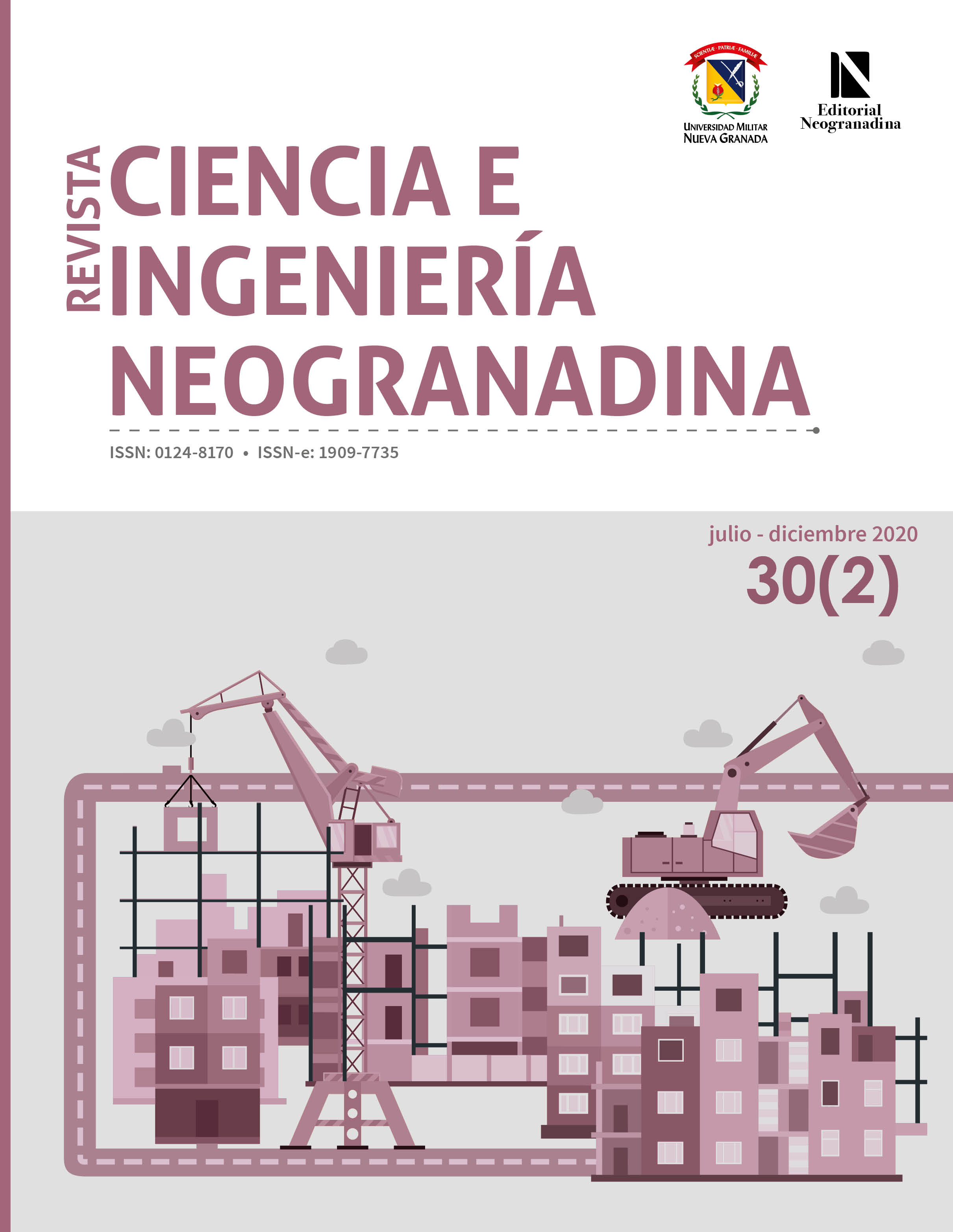Revisión de métodos para la clasificación de fallas superficiales en pavimentos flexibles
Resumen
El estado de la infraestructura vial impacta el entorno social, económico y político de una nación. La evaluación de la condición superficial del pavimento es esencial para planificar intervenciones oportunas y eficaces. Las acciones oportunas evitan sobrecostos de operación, impiden el deterioro no controlado y disminuyen los inconvenientes operacionales y de seguridad. El problema expuesto plantea la inquietud de estudiar alternativas para evaluar el estado del pavimento, por lo cual un gran número de investigaciones sobre detección automática de fallas superficiales en pavimentos flexibles a través de técnicas de procesamiento de imágenes han sido desarrolladas. El objetivo de este artículo es revisar y analizar estos aportes. Sobre la base de la revisión, se concluyó que el rendimiento de este tipo de sistemas está determinado por dos factores: la recopilación de los datos y su procesamiento. El análisis presentado se despliega en función de estos factores. Se considera oportuno el desarrollo de sistemas que aprovechen las cualidades de diferentes sensores en la adquisición de datos y que integren la detección y clasificación de variedad de fallas incluyendo datos de severidad.Descargas
Agencias de apoyo:
Universidad del ValleReferencias bibliográficas
D. E. GarzónBejarano, Qué incidencia tiene la ausencia de infraestructura en transporte en el crecimiento económico de un país, tesis ba, Facultad de Ciencias Económicas de la Universidad Militar de Nueva Granada, Bogotá, 2016. Disponibleen: https://repository.unimilitar.edu.co/bitstream/handle/10654/14198/GarzonBejaranoDiegoEnrique2016.pdf?sequence=1&isAllowed=y
(2017, feb. 8). “Plan Estratégico Institucional 2015 2018 V 2”, Invías. [Internet]. Disponible en https://www.invias.gov.co/index.php/archivo-y-documentos/hechos-de-transparencia/planeacion-gestion-y-control/plan-estrategico-institucional/5455-plan-estrategico-institucional-2015-2018-v-2
(2018, dic. 28). “Estado de la red vial criterio técnico segundo semestre del 2018”, Invías. [Internet]. Disponible en https://www.invias.gov.co/index.php/archivo-y-documentos/informacion-institucional/8397-estado-de-la-red-vial-criterio-tecnico-segundo-semestre-2018
M. Á. Morillo Romero, Digitalización 3D con escáner de luz estructurada aplicada al área de la gestión de calidad y la conservación del patrimonio históricoartístico, tesis ba, Departamento de Física Aplicada de la Escuela Técnica Superior de Ingeniería de la Universidad de Sevilla, Sevilla, 2015.
L. Bursanescuy M. Bursanescu,“Three-linehigh-power three-dimensional sensor”, in Three-Dimensional Image Capture and Applications; ed. R. N. Ellson, vol. 3313, SPIE International Society for Op- tics and Photonics, 1998, pp. 105-114. doi: https://doi.org/10.1117/12.302443
L. Bursanescu y M. Hamdi, “Three-dimensional laser ranging image reconstruction using three-line laser sensors and fuzzy methods”, in Three-Dimensional Imaging, Optical Metrology, and Inspection V; ed. K. G. Harding, Boston: SPIE International Society for Optics and Photonics, 1999, pp. 106-117. doi: https://doi.org/10.1117/12.370251
W. Li, J. Huyan y S. L. Tighe, “Pavement Cracking Detection Based on Three-Dimensional Data Using Improved Active Contour Model”, Jour. of Transp. Eng., vol. 144, n.° 2, 2018. doi: https://doi.org/10.1061/JPEODX.0000028
Y. Turkan, J. Hong, S. Laflamme y N. Puri, “Adap- tive wavelet neural network for terrestrial laser scanner-based crack detection”, Automat. in Const., vol. 94, pp. 191-202, 2018. doi: https://doi.org/10.1016/j.autcon.2018.06.017
Y. Yu, H. Guan y Z. Ji, “Automated Detection of Urban Road Manhole Covers Using Mobile Laser Scanning Data”, ieee Transac. on Intellig. Transp. Syst., vol. 16, n.° 6, pp. 3258-3269, 2015. doi: https://doi.org/10.1109/TITS.2015.2413812
W. Ouyang y B. Xu, “Pavement cracking measurements using 3D laser-scan Images”, Measur. Sci. and Tech., vol. 24, n.° 10, 2013. doi: https://doi.org/10.1088/0957-0233/24/10/105204
J. Huang y W. Liu, “A pavement crack detection method combining 2D with 3D information based on DempsterShafer”, Comp.-Aided Civ. and Infr., vol. 29, n.° 4, pp. 299-313, 2014. doi: https://doi.org/10.1111/mice.12041
R. Gui, X. Xu, D. Zhang, H. Lin, F. Pu, L. He y M. Cao, “A component decomposition model for 3D laser Scanning Pavement data based on high-pass filtering and sparse analysis”, Sensors, vol. 18, n.° 7, p. 2294, 15, jul., 2018. doi: https://doi.org/10.3390/s18072294
X. M. Sun, J. P. Huang y W. Y. Liu, “Decision model in the laser scanning system for pavement crack de- tection”, Optic. Eng., vol. 50, n.° 12, pp. 107-207, 2011. doi: https://doi.org/10.1117/1.3662424
H. Xing-Fei y O. Nixon, “Time Delay Integration Speeds Up Imaging”, Jour. Phot. Spect., vol. 46, n.° 5, p. 50, may. 2012.
M. Yao, Z. Zhao, X. Yao y B. Xu, “Fusing complementary images for pavement cracking measurements”, Measur. Sci. and Tech., vol. 26, n.° 2, 2015. doi: https://doi.org/10.1088/0957-0233/26/2/025005
X. Yao, M. Yao y B. Xu, “Automated Measurements of Road Cracks Using Line-Scan Imaging”, Jour. of Test. and Eval., vol. 39, n.° 4, pp. 621-629, 2011. doi: https://doi.org/10.1520/JTE103331
L. Qingquan, Z. Qin, Z. Daqiang y M. Qingzhou, “FoSA: F* seed-growing approach for crack-line detection from pavement images”, Imag. and Vis. Comp., vol. 29, n.° 12, pp. 861-872, 2011. doi: https://doi.org/10.1016/j.imavis.2011.10.003
Y. Huang y B. Xu, “Automatic inspection of pavement cracking distress”, Jour. Of Elect. Imag., vol. 15, n.° 1, pp. 13-17, 2006. doi: https://doi.org/10.1117/1.2177650
M. Gavilán, D. Balcones, O. Marcos, D. F. Llorca, M. A. Sotelo, I. Parra, M. Ocaña, P. Aliseda, P. Yarza y A. Amírola, “Adaptive Road Crack Detection Sys- tem by Pavement Classification”, Sensors, vol. 11, n.° 10, pp. 9628-9657, 2011. doi: https://doi.org/10.3390/s111009628
N.-D. Hoang, Q.-L. Nguyen y V.-D. Tran, “Automa- tic recognition of asphalt pavement cracks using me- taheuristic optimized edge detection algorithms and convolution neural network”, Automat. in Const., vol. 94, pp. 203-213, 2018. doi: https://doi.org/10.1016/j.autcon.2018.07.008
M. H. Yousaf, K. Azhar, F. Murtaza y F. Hussain, “Visual analysis of asphalt pavement for detection and localization of potholes”, Adv. Eng. Informatics, vol. 38, pp. 527-537, 2018. doi: https://doi.org/10.1016/j.aei.2018.09.002
F. Meng y A. Li, “Pavement crack detection using Sketch Token”, Proced. Comp. Sci., vol. 139, pp. 151-157, 2018. doi: https://doi.org/10.1016/j.procs.2018.10.231
N.-D. Hoang, “Classification of asphalt pavement cracks using laplacian pyramid-cased image processing and a hybrid computational approach”, Comput. Intellig. and Neurosci., vol. 2018, 2018. doi: https://doi.org/10.1155/2018/1312787
N.-D. Hoang y Q.-L. Nguyen, “Fast local laplacian-based steerable and sobel filters integrated with adaptive boosting classification tree for automatic recognition of asphalt pavement cracks”, Adv. in Civ. Eng., vol. 2018, pp. 1-17, 2018. doi: https://doi.org/10.1155/2018/5989246
N.-D. Hoang y Q.-L. Nguyen, “Automatic recognition of asphalt pavement cracks based on image processing and machine learning approaches: Comparative study on classifier performance”, Math. Prob. in Eng., vol. 2018, pp. 1-16 2018. doi: https://doi.org/10.1155/2018/6290498
N.-D. Hoang, “An artificial intelligence method for asphalt pavement pothole detection using least squares support vector machine and detection”, Adv. in Civ. Eng., vol. 2018, pp. 1-12, 2018. doi: https://doi.org/10.1155/2018/7419058
H. Maeda, Y. Sekimoto, T. Seto, T. Kashiyama y H. Omata, “Road damage detection using deep neural networks with images captured through a smartpho- ne”, Comp.-Aided Civ. and Infrastruc. Eng., vol. 33,n.° 12, pp. 1127-1141, 2018. doi: https://doi.org/10.1111/mice.12387
Q. Zou, Z. Zhang, Q. Li, X. Qi, Q. Wang y S. Wang, “DeepCrack: learning hierarchical convolutional fea- tures for crack detection”, ieee Transact. on Imag. Process., vol. 28, n.° 3, pp. 1498-1512, 2019. doi: https://doi.org/10.1109/TIP.2018.2878966
F. M. Nejad y H. Zakeri, “An optimum feature ex- traction method based on Wavelet–Radon transform and dynamic neural network for pavement distress classification”, Expert Syst. with Applic., vol. 38, n.° 8, pp. 9442-9460, 2011. doi: https://doi.org/10.1016/j.eswa.2011.01.089
F. M. Nejad y H. Zakeri, “A comparison of multi-re- solution methods for detection and isolation of pavement distress”, Exp. Syst. with Applic., vol. 38, n.° 3, pp. 2857-2872, 2010. doi: https://doi.org/10.1016/j.eswa.2010.08.079
L. Inzerillo, G. D. Mino y R. Roberts, “Image-based 3D reconstruction using traditional and uav datasets for analysis of road pavement distress”, Automat. in Const., vol. 96, pp. 457-469, 2018. doi: https://doi.org/10.1016/j.autcon.2018.10.010
M. Stanie y P. Czech, “Self-correcting neural network in road pavement diagnostics”, Automat. in Const., vol. 96, pp. 75-87, 2018. doi: https://doi.org/10.1016/j.autcon.2018.09.001
R. J. Dobson, T. Colling, C. Brooks, C. Roussi, M. Kueber y D. Dean, “Collecting Decision Support System Data Through Remote Sensing of Unpaved Roads”, Transp. Res. Rec.: Jour. of the Transp. Res. Board, vol. 2433, n.° 1, pp. 108-115, 2014. doi: https://doi.org/10.3141/2433-12
S. Zhang, C. D. Lippitt y S. M. Bogus, “Characterizing pavement surface distress conditions with hyper-spa- tial resolution natural color aerial photography”, Re- mote Sens., vol. 8, n.° 5, p. 392, 2016. doi: https://doi.org/10.3390/rs8050392
H. Zakeri, F. M. Nejad y A. Fahimifar, “Rahbin: A quadcopter unmanned aerial vehicle based on a systematic image processing approach toward an automated asphalt pavement inspection”, Automat. in Const., vol. 72, n.° 2, pp. 211-235, 2016. doi: https://doi.org/10.1016/j.autcon.2016.09.002
N. Shatnawi, “Automatic pavement cracks detec- tion using image processing techniques and neural network”, Internat. Jour. of Adv. Comp. Sci. and Ap- plic., vol. 9, n.° 9, pp. 399-402, 2018. doi: https://doi.org/10.14569/IJACSA.2018.090950
Y. Pan, X. Zhang, G. Cervone y L. Yang, “Detection of asphalt pavement potholes and cracks based on the unmanned aerial vehicle multispectral imagery”, ieee Jour. of Select. Top. in Appl. Earth Observ. and Re- mote Sens., vol. 11, n.° 10, pp. 3701-3712, 2018. doi: https://doi.org/10.1109/JSTARS.2018.2865528
S. Zhang, S. M. Bogus, C. D. Lippitt, P. R. Neville, G. Zhang, C. Chen y V. Valentin, “Extracting pavement surface distress conditions based on high spatial resolution multispectral digital aerial photography”, Photo- gram. Eng. & Remote Sens., vol. 81, n.° 9, pp. 709-720, 2015. doi: https://doi.org/10.14358/PERS.81.9.709
S. Pascucci, C. Bassani, A. Palombo, M. Poscolieri y R. Cavalli, “Road asphalt pavements analyzed by air- borne thermal remote sensing: preliminary results of the Venice highway”, Sensors (Basel), vol. 8, n.° 2, pp. 1278-1296, 2008. doi: https://doi.org/10.3390/s8021278
M. Ribeiro Resende, L. L. Bariani Bernucci y J. A. Quintanilha, “Monitoring the condition of roads pavement surfaces: proposal of methodology using hyper- spectral images”, Jour. of Transp. Lit., vol. 8, n.° 2, pp. 201-220, 2014. doi: https://doi.org/10.1590/S2238-10312014000200009
H. Lokeshwor, L. K. Das y S. Goel, “Robust method for automated segmentation of frames with/with- out distress from road surface video clips”, Jour. of Transp. Eng., vol. 140, n.o 1, pp. 31-41, 2014. doi: https://doi.org/10.1061/(ASCE)TE.1943-5436.0000564
C. Koch y I. Brilakis, “Pothole detection in asphalt pavement images”, Adv. Eng. Inform., vol. 24, n.° 3, 2011. doi: https://doi.org/10.1016/j.aei.2011.01.002
G. M. Hadjidemetriou, P. A. Vela y S. E. Christodou- lou, “Automated pavement patch detection and quan- tification using support vector”, Jour. of Comp. in Civ. Eng., vol. 32, n.° 1, 2018. doi: https://doi.org/10.1061/(ASCE)CP.1943-5487.0000724
W. Y. Yan y X.-X. Yuan, “A low-cost video-based pavement distress screening system for low-volume roads”, Jour. of Intellig. Transp. Syst., vol. 22, n.° 5, pp. 376-389, 2018. doi: https://doi.org/10.1080/15472450.2017.1366320
R. Madli, S. Hebbar y P. Pattar, “Automatic detection and notification of potholes and humps on roads to aid drivers”, ieee Sens. Jour., vol. 15, n.° 8, pp. 4313-4318, 2015. doi: https://doi.org/10.1109/JSEN.2015.2417579
M. Bellone y G. Reina, “Pavement distress detection and avoidance for intelligent vehicles”, Internat. Jour. of Vehic. Autonom. Syst., vol. 13, n.° 2, pp. 152-167, 2016. doi: https://doi.org/10.1504/IJVAS.2016.078810
M. Tan, S. Liang y X. Y. Li, “Design of a low-cost detecting and locating system for pavement distress- es based on vibration acceleration signal”, icic Expr. Lett., 2016.
M. R. Jahanshahi, F. Jazizadeh, S. F. Masri y B. Becerik-Gerber, “Unsupervised approach for Autonomous pavement defect detection and quantification using an inexpensive depth sensor”, Jour. of Comp. in Civ. Eng., vol. 27, n.° 6, pp. 743-754, 2013. doi: https://doi.org/10.1061/(ASCE)CP.1943-5487.0000245
(2020). “Fugro”. [Internet]. Disponible en: https://www.fugro.com/our-services/asset-integrity/roadware/aran-automatic-road-analyzer#tabbed1. [Último acceso: 11 agosto 2018].
(2015). “The digital highway data vehicle (dhdv)”. [Internet]. Disponible en: http://www.pvision3d.com/Home/DHDV .
(2020). “Leica Geosystems”. [Internet]. Disponible en: https://leica-geosystems.com/products/mobile-sensor-platforms/capture-platforms/leica-pegasus_two-ultimate.
(2019, ag. 31). Pasco. [Internet]. Disponible en: https://www.pasco.co.jp/eng/products/real/.
(2020). Dynatest. [Internet]. Disponible en: https://www.dynatest.com/multi-functional-vehicle-mfv.
(2020) Raurosgroup. [Internet]. Disponible en: http://www.raurosgroup.com/Servicios.
A. González, F. Martínez, A. Pernia, F. Alba, M. Castejon, J. Ordieres y E. Vergara, Técnicas y algortimos básicos de visión artificial, España: Servicio de Publicaciones Universidad de la Rioja, 2006.
P. Subirats, J. Dumoulin, V. Legeay y D. Barba, “Auto- mation of pavement surface crack detection using the continuous wavelet transform”, Imag. Process., vol. 1, n.° 1, pp. 3037-3040, 2006. doi: https://doi.org/10.1109/ICIP.2006.313007
A. Ayenu-Prah y N. Attoh-Okine, “Evaluating pavement cracks with bidimensional empirical mode decomposition”, Eurasip Jour. on Adv. in Sig- nal Process., vol. 2008, p. 7, 2008. doi: https://doi.org/10.1155/2008/861701
J. Wang y R. X. Gao, “Pavement distress analysis based on dual-tree complex wavelet transform”, Internat. Jour. of Pavem. and Tech., vol. 5, n.° 5, pp. 283- 288, sept., 2012.
B. Javidi, J. Stephens, S. Kishk, T. Naughton, J. Mc- Donald y A. Isaac, “Pilot for automated detection and classification of road surface degradation features”, Reporte Técnico JHR 03-293, Connecticut Transportation Institute, University of Connecticut, 2003.
L. Qingquan y L. Xianglong, “A model for segmentation and distress statistic of massive pavement images based on multi-scale strategies”, Rem. Sens. and Spat. Inf. Sci., vol. 37, pp. 63-67, 2008.
H. Edwards, How Machines Learn. [Libro digital], IntelligentsIA Research, 2016.
J. Lin y. Liu, “Potholes detection based on svm in the pavement distress image”, en Proceedings - 9th Inter- national Symposium on Distributed Computing and Applications to Business, Engineering and Science (dcabes), pp. 544-547, Hong Kong, China: ieee ag. 2010. doi: https://doi.org/10.1109/DCABES.2010.115
L. Zhang, F. Yang, Y. D. Zhang y. J. Zhu, “Road crack detection using deep convolutional neural net- work”, en 2016 ieee International Conference on Im- age Processing (icip), Phoenix, 2016. doi: https://doi.org/10.1109/ICIP.2016.7533052
M. Eisenbach, R. Stricker, D. Seichte, K. Amende, K. Debes, M. Sesselmann, D. Ebersbach, U. Stoeckert y H.-M. Gross, “How to get pavement distress detection ready for deep learning? A systematic approach”, en 2017 International Joint Conference on Neural Net- works (ijcnn), Anchorage, usa, 2017. doi: https://doi.org/10.1109/IJCNN.2017.7966101
S. Haykin, Neural Networks and Learning Machines, New York: Prentice Hall, 2009.
Guerra, A, “Aprendizaje automático: árboles de decisión”, Universidad Veracruzana, Facultad de Física e Inteligencia Artificial, Maestría en Inteligencia Artificial, Notas de Clases, 2004.
S. Mokhtari, Analytical Study of Computer Vi- sion-Based Pavement Crack Quantification Using Machine Learning Techniques, tesis Ph. D., Departa- mento de ingeniería civil, ambiental y de construcción, College of Engineering and Computer Science, University of Central Florida, Orlando, Florida, 2015.












